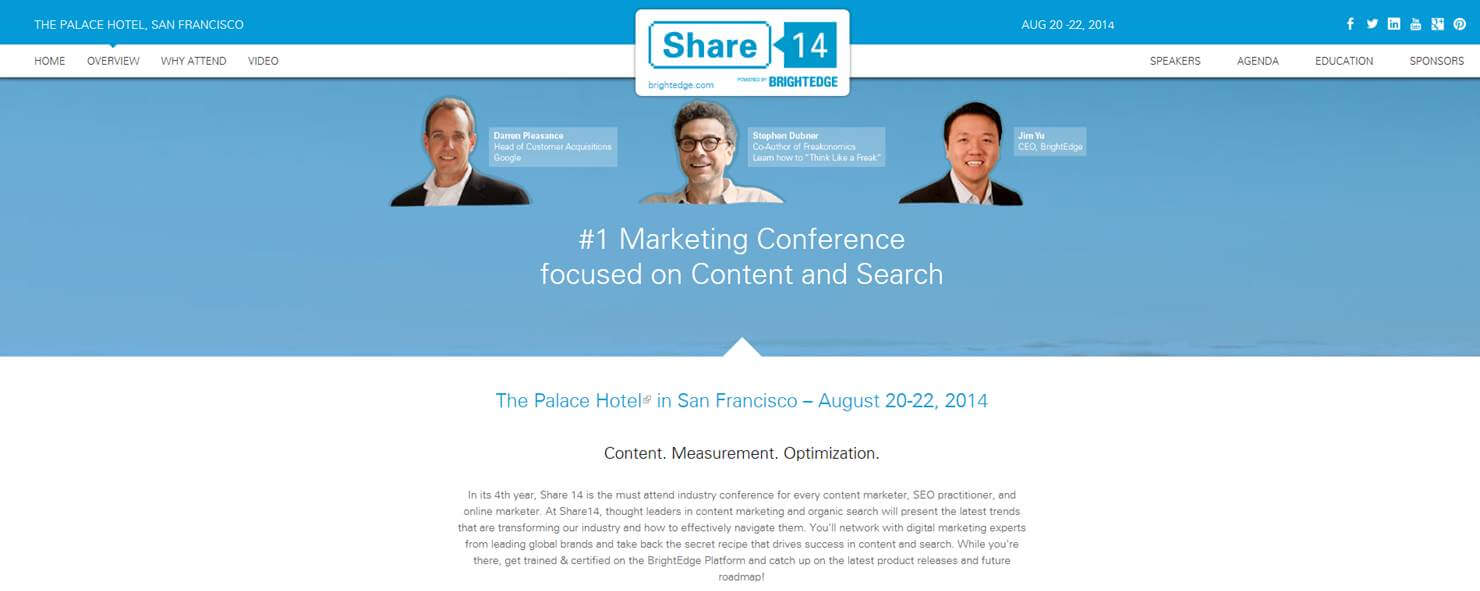Share14 was high on my list of 2014 conferences not to miss, and it delivered. The impressive speaker line-up included SEO professionals from large enterprise organizations such as BING, Google, M3 and Marriott International sharing insider tips and tactics that we can use to help clients at our own agency.
The overall focus of this year’s SEO conference was on local, site usability, mobile and of course, content. With that in mind I want to share with you the top 4 things that I learned at the conference.
1. What does local really mean?
Google’s more recent algorithm update hummingbird has really pushed the emphasis on local, exposing its importance in the mind of Google. But what does local really mean? Quite often when we talk about local we don’t really put ourselves in the users shoes and think about the practical user experience and what their true intent is at the time they search.
Duane Forrester, from Bing, really put a practical light on what local actually means and the challenges the search engines have when it comes to understanding the true intent of a local searcher.
He talked about how data signals are everywhere and anywhere, especially in local search. When we as users search for local information there are many different data points that the search engines must consider, one of these being ‘what is the users true search intent’?
When discussing intent the search engines want to understand the true need of the users and provide them with the most accurate results in the fastest way possible.
Although this is not an official definition of what local is it definitely helps us understand the complexity of how we need to interpret local search.
Duane went on to say that local can be any or all of the following things:
- Nearby
- Within a mile
- Local to me now
- Local to me later
Reviewing these perspectives helps SEO professionals think about user true intent and how this can relate to business. Prompting such questions as: As a business what type of service or product do you offer and where does it fit into a local users purchase cycle? Does your content match up with the intent of your target users? Is your business a local to me now or later for searchers?
As the search engines continue to focus on the local search results it is important to really think about who your customers are and figure out how your business fits into THIER lives. This perspective alone should help shift the way you position your SEO content strategy and the type of information you are offering potential customers. With the amount of content being put online everyday it is important to get to the point and provide the best answers for customers no matter where they are or, when or how they need you.
2. The Challenging Customer journey
Everyday millions of people are adding content to the web; at times, the rate of new content available can be overwhelming to users.
With all of this content, consumers have more choice than ever before. However, how does this impact the customer purchase journey? How does this impact what type of content businesses need to publish online?
Raj Rao, the VP of 3M, spoke about this exact issue and the need to understand that marketing needs to meet the need of online consumers much quicker than before.
Raj stated that ‘consumer attention spans are getting shorter; information is coming at us at an alarming rate and there are many more touch points that can influence or distract ones attention.’
So how does business overcome this? How can we get the attention of the right customers at the right time?
Raj continued to explain how important it is to make sure we research and understand our customers to help define what it is they really want at all points in their purchase process. Once we understand who it is we are talking too we can start to interact with them by giving them content that directly answers their search queries. It is when consumers find the right information at the right time that it attracts their attention towards a certain product or brand.
Raj’s content marketing formula looks as follows:
Research customers > define customer needs > answer needs via content > structure site so it is easy to use > rinse / repeat
I agree that we are overwhelmed with choices as we search online for answers and information. In this time sensitive day and age, we really need to make sure that businesses are delivering content that impacts the consumer quickly. By providing the right content at the right time to target audiences brands build trust and authority that helps influence consumer choice in purchase or services.
Which of course leads me onto my next point…
3. Digital content is becoming the heavy influencer
Content used to be king. Now we like to say content is currency. How does your content influence and impact your organizations bottom line? With all this talk today about content marketing and the need to engage with target audiences it is important to note that engagement is only one piece of the pie. We need to consider how much influence our content has as consumers visit many different websites which can all work to impact their purchasing decisions.
Again Raj Rao, from M3, talked about content as a strong influencer in the customers purchasing journey. He spoke about how there are three things to consider when it comes to content as an influencer.
1. Discovery: The first step in the process is, discovery. Is your content being found? Is it being found by the right people? If no one is reading it or sharing it your influence will be low no matter how great the content might be.
2. Influence: Assuming that the content is being found and read by consumers, is your content actually influencing them towards your brand? Are you building a reputation as a trusted authority in your industry? By understanding your audience needs and desires you can start to shape your content towards their interest and not your own. With this you will start to generate more engagement and followers which will help build your online audience.
3. Transaction: Does your content lead to specific transactions? Are you creating content with your overall revenue goals in mind? Your content strategy should aim to have a specific influence with your readers to help them take steps towards making a transaction. Your content should work to not only influence your readers but build trust and help steer them towards a specific service or product that you offer.
In order to help create content that influences we need to know our audience and start to think human. Does your content practically help your users or is it just marketing ‘jargon’ that tells people how great you are? Once we have this understanding and perspective it is only then that we can start to meet the needs of consumers as we are actually aiming to relate and help them by sharing our expertise.
4. How to impact local in a multi-location businesses
This difficult task really interested me as our agency, although it is not everything we do, specializes heavily in this area of digital marketing. How can large enterprise organizations with many locations make an impact at the local level?
As we have discussed, Google is really focused on the local markets and helping local brands win in the search results. With this in mind it is important for these multiple location businesses to be active and relevant online with up to date content that will engage readers. So how can you do this in a scalable way?
It has always been my belief that local businesses in different geographical regions are going to the best voice for any business as they know the local business landscape and customer audience. By having this local knowledge it is really important to get these businesses involved by having them sharing local insights, stories and news which will in turn help them build authority in their business niche.
Michael Jozaitis Manager & SEO Strategist for Marriott International encountered this exact problem. With over 800 hotel locations worldwide, Michael faced the problem of getting more visibility for each hotel in their local markets. So what was their strategy?
Michael knew that it was near impossible for his SEO team to create content and be active in each of those 800 locations so they had to come up with a plan to get employee’s at each location to participate. From the outside this sounds like a great idea however, Marriott had to be sure to protect their brand and not steer ship into a social media reputation crisis in the process.
What Michael and his team did was actually creative and quite simple in nature. With the need to get local social media involvement the team created a ‘Social Playbook’ that offered a very high level overview of how each of the social platforms were used by Marriott and how employees can participate.
The goal of the social playbook was to train and empower the people while ensuring that Marriott Internationals interests were considered with every post shared online. It essentially gave all employees a very high level ‘what to do and what not to do’ guide on what type of content was acceptable to share. It also allowed employees to understand the social media platforms and participate to help build recognition within the company itself. While not all of the employees use social media it at least allowed Marriott to build locally with the employees that did. Smart!
What a great strategy to help a worldwide brand be active and relevant in local markets. Scaling social and content marketing is difficult without the help of those around you. In the case of Marriott they were able to leverage their best assets, their employees. This allowed them to use people who not only knew their brand but, also the local market. Win-Win!
Overall the conference was a great success and the many speakers that participated had other excellent SEO insights that continued to shed light on the importance of content and its overall impact on the customers purchase journey. The biggest insight to be taken away from Share14 is that by truly understanding customers’ intent at the local level you have a greater chance of impacting their purchase decisions; by producing great content you will help influence them towards your brand.
Interested in finding out more? Contact us today!





